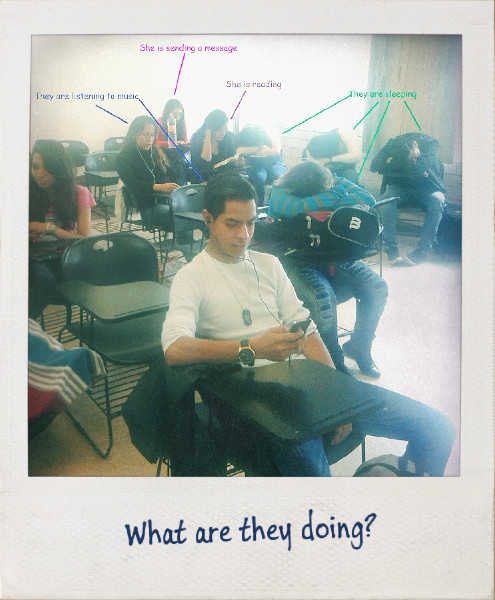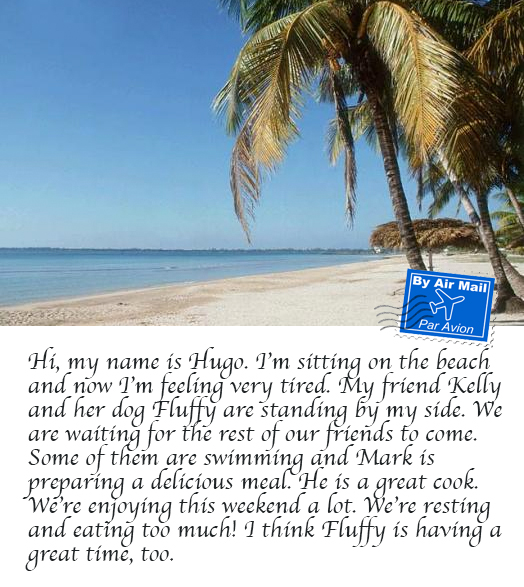The present continuous is essential because it shows us when someone is doing something.
The focus of present continuous is the continuous action and emphasises on its progress.
In this topic, you are going to work with different skills. First, you are going to:
• Read about Hugo and his friends spending a weekend on the beach.
• Listen to Megan trying to talk to her friends on the phone, but none of them is available.
• Write an e-mail to Richard explaining what your family members are doing. You are going to describe pictures of people doing activities.
• Talk about pictures of people doing activities.
So, let’s start!

(Reyes,2016)
By the end of this topic, you will:
Be able to express ideas about your daily life, give and get detailed information about actions happening at the moment of speaking.
At this moment, you are reading this, and at the same time, studying English. What do you think your classmates, friends, teachers or acquaintances are doing right now?
Are they studying? Are they speaking? Are they listening to music? Are they sleeping? Are they eating?
If they are not doing the previous activities… What are they doing then?

Reyes, 2016. Student.
Let’s check it out!
So, the moment has come to check the form, use and examples of the use of the present continuous. Have a look at the following information.
Present Continuous is formed with the verb to be and the main verb with the –ing ending. The verb to be must be conjugated according to the subject of the sentence. We use this tense to talk about the actions that are happening at the moment of speaking.
Look at these examples.
• I am reading the information now.
• Look! Gaby is answering some questions.
• We are learning a new language right now.
Take a look to this box.
Affirmative |
Negative |
Interrogative |
I am eating. |
I am not eating. |
Am I eating? |
You are studying. |
You are not studying. |
Are you studying? |
He is singing |
He is not singing. |
Is he singing? |
She is dancing. |
She is not dancing. |
Is she dancing? |
It is raining. |
It is no training. |
Is it raining? |
We are speaking. |
We are not speaking. |
Are we speaking? |
They are walking. |
They are not walking. |
Are they walking? |
Note: You can use contractions in both, affirmative and negative sentences.
Affirmative |
Negative |
I’m eating. |
I’m not eating. |
You’re studying. |
You’re not eating or You aren’t eating. |
He’s singing. |
He’s not singing or He isn’t singing. |
She’s dancing. |
She’s not dancing or She isn’t dancing. |
It’s raining. |
It’s not raining or It isn’t raining. |
We’re speaking. |
We’re not speaking or We aren’t speaking. |
They’re walking. |
They’re not walking or They aren’t walking. |
To form the Present Participle (-ing) there are some simple rules.
VERB |
VERB -ING |
be |
being |
think |
thinking |
drink |
drinking |
dream |
dreaming |
see |
seeing |
cry |
crying |
play |
playing |
But there are some exceptions:
VERB |
VERB -ING |
drive |
driving |
lose |
losing |
live |
living |
dance |
dancing |
VERB |
VERB -ING |
swim |
Swimming |
run |
running |
plan |
Planning |
stop |
Stopping |
begin |
Beginning |
VERB |
VERB -ING |
die |
dying |
lie |
lying |
tie |
tying |
Activity 1
When reading the news, you need to be sure that you understand the ideas correctly.
The following text is about Hugo, a boy who is spending a weekend at the beach with some of his friends. Read the paragraph and then choose T (true) or F (false). At the end of the activity, you can check and assess your performance.

Mauricio (2017)
Activity 2
You are sending this postcard to a family member, but first, read the following:example
Now it is your turn to describe what you and your friends are doing. Remember that before you finish your description; make sure it has the characteristics contained in the following rubric.

Tiphbeg. (2015). Friends. Retrieved from: https://pixabay.com/es/amigos-puesta-del-sol-playa-589353/.
Activity 3
Do you like talking on the phone? Click on the image and listen to Meredith making phone calls to her friends. What are her friends doing? Then, match the columns.
Click here to listen to the audio.

NA. (2012). Phonecall. Retrieved from https://pixabay.com/es/llamada-llamar-a-celular-15758/.
Based on the audio, match the elements from the bottom to the appropriate space. You have two attempts to answer each exercise. At the end of the exercise, you can find your results.
Activity 4
Do you know what is your friend doing now? Call him!

PeteLinforth. Emotion. Retrieved from https://pixabay.com/es/emoci%C3%B3n-tel%C3%A9fono-emoji-1740913/
Write a phone conversation. Keep in mind the following:
Read the following example:
Before you write your description, make sure it has the characteristics contained in the following rubrics.
Activity 6
Look at the pictures and describe what each person is doing. First, listen to the following example:
Write the descriptions you will be recording and use the following rubrics to evaluate yourself.

Na. (2015). Corredor. Retrieved form: https://pixabay.com/es/corredor-carrera-la-competencia-888016/
Let’s play one of the famous games in English called: Hangman. Write the -ing form of the verbs before you get hung. Use questions on how the Present participle is formed. At the end of the exercise, you can check your results.
Play the audio and fill in the blanks with the words or phrases you hear.
Rewrite the sentences in negative and interrogative form, but do not use contractions.
• Thornbury, S. (2004). Natural Grammar. Oxford.
• Azar, S. & Hagen, S. (2009). Understanding and using English Grammar. Pearson Longman.
• Coordinación de Universidad Abierta y Educación a Distancia, UNAM. (2011). English media. Retrieved from: http://www.cuaed.unam.mx/english_media/
• English Page.com. (2016). Present Continuous. Retrieved from: https://www.englishpage.com/verbpage/presentcontinuous.html